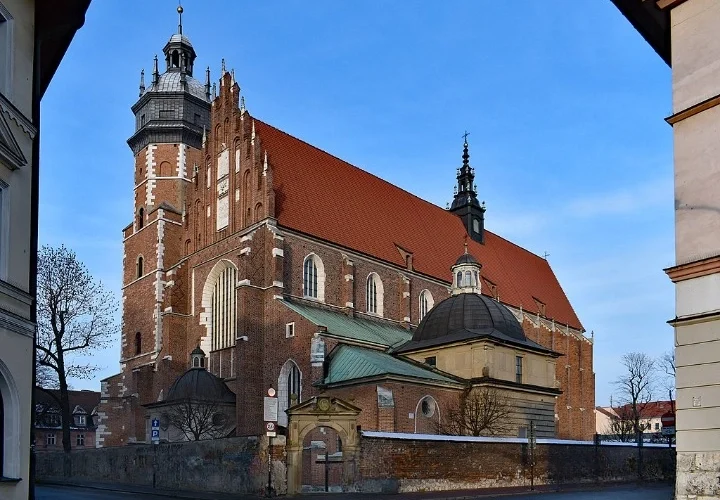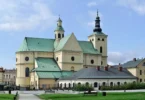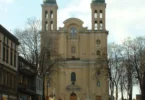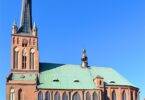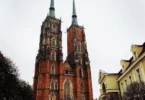Introduction
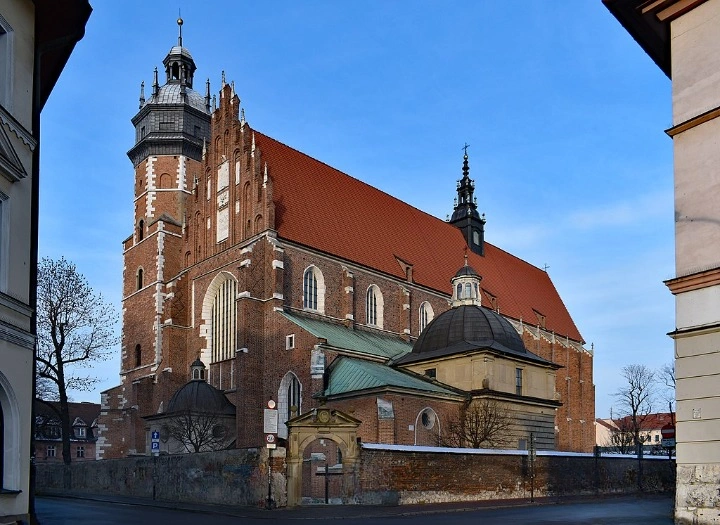
The Corpus Christi Basilica (Polish: Bazylika Bożego Ciała) is a massive, old Gothic church tucked away in Kraków’s Kazimierz district. It was founded way back in 1335 by King Casimir III the Great, and it still stands as one of the most impressive churches in the city. You’ll find it at 26 Bożego Ciała Street, right in the heart of Kazimierz what used to be the old Jewish quarter, and now one of Kraków’s most historic and atmospheric neighborhoods. It’s not just any church. Corpus Christi is both a parish church and a monastic church, home to the Canons Regular of the Lateran, a religious order that’s been here for centuries. It’s also considered a double sanctuary dedicated to the Blessed Virgin Mary, Mother of the Savior, and to St. Stanislaus of Kazimierczyk, who lived and served here.
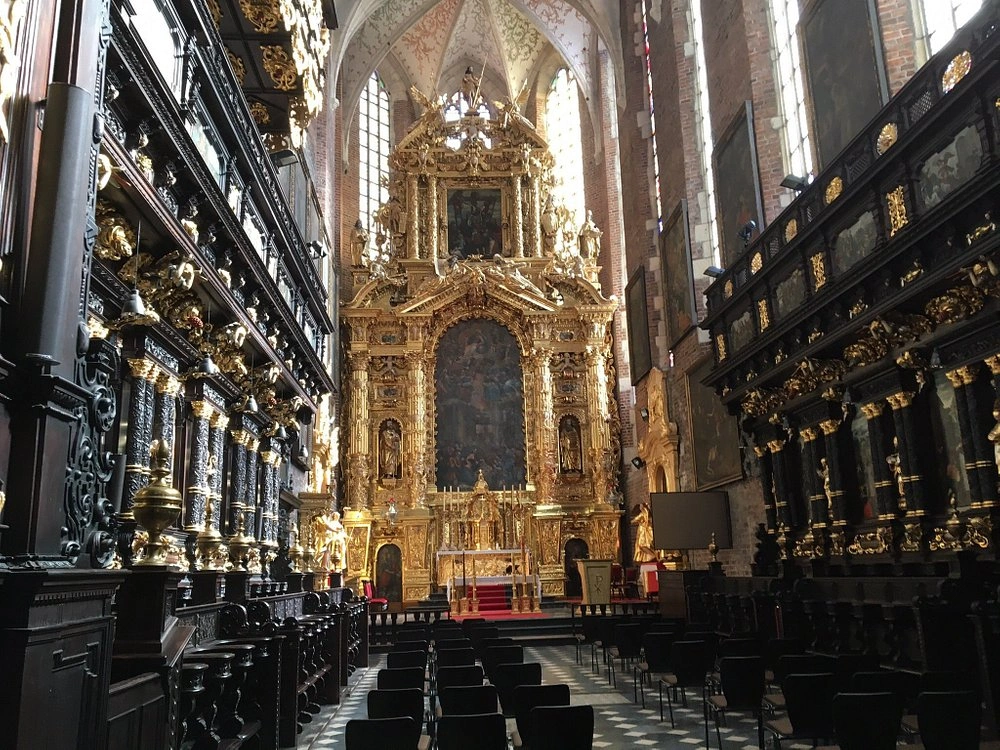
The brick church was founded around 1340 by Casimir the Great. The foundations for the entire church were laid in the 1340s, and the chancel walls were raised to a height of 12 meters. However, construction was put on hold after 1348, possibly due to the spread of the plague throughout Europe. Since 1369, when the Kazimierz-based mason Cypser received payment for his work on the church, construction has continued. Accounts mention Jan Cypser, his son Mikołaj, and the mason Piotr. In 1376, work began on the sacristy located at the northern wall of the chancel. The chancel was consecrated in 1401, but the Cypsers’ work on the nave continued until 1405, when Władysław Jagiełło brought regular canons from Kłodzko. A monastery was built for them next to the church in later years. Up until 1477, construction on the church continued. The gable of the façade was added only around 1500, and the tower was built between 1566 and 1582. Pope John Paul II, by decree of the Congregation for Divine Worship and the Discipline of the Sacraments of January 24, 2005, elevated the church to the rank of minor basilica . The basilica is the urban focal point of a vast building complex that also includes a oriented church and a regular canons’ monastery, both of which were established in 1405, and are connected by an arcaded passageway. St. Stanislaus of Casimir is buried there. The Passion Cemetery, which featured representations of Ogrójec, the Mount of Olives, and Golgotha and was an important part of the church’s medieval surroundings, was leveled in 1938–1940.
Architecture of Basilica of Corpus Christi, Krakow, Poland
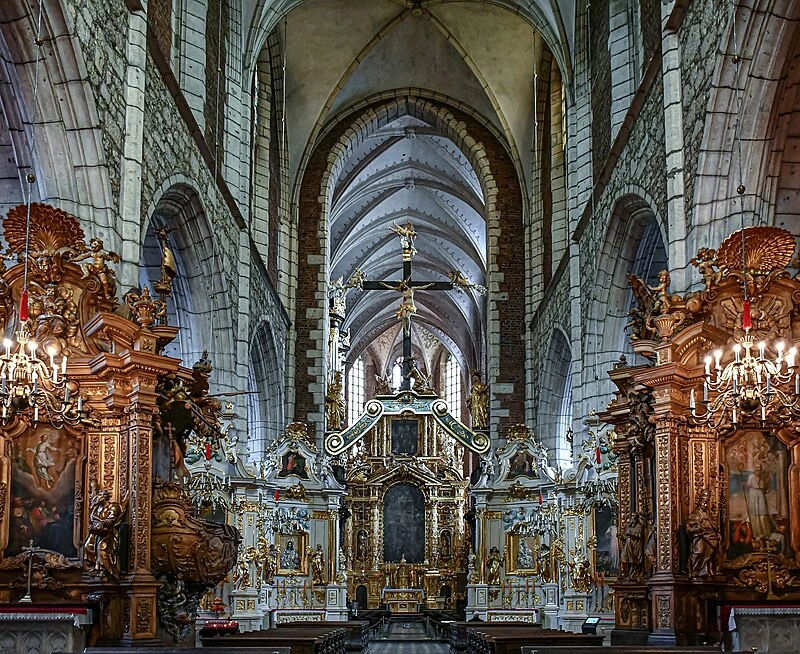
Architectural style: Gothic architecture, Baroque architecture, Romanesque architecture.
Burials: Stanisław Kazimierczyk.
Interior
The interior of the church is a mixture of Polish Gothic and impressive Polish Baroque architecture with structural features such as a large gilded Baroque high altar, a boat-shaped pulpit (1750), and the organ. The church was robbed clean and the interior utterly devastated by soldiers of the 1655 Swedish invasion (the Deluge), which explains the prevalence of Baroque in its current decoration. The church is said to contain one of the most beautiful Baroque choir stalls in Central Europe. Bartolommeo Berrecci, the Renaissance artist who designed Sigismund’s Chapel at Wawel, is buried there. The largest organs in Krakow are housed in Corpus Christi Basilica. The main instrument was built between 1958 and 1963 using some elements of the old organ dating back to the 1770s. It was designed for 83 pitches and consists of two parts. The choir’s main organ and the chancel’s side organs are located there. There are 25 bells and 5950 pipes in all of the organs. They have the ability to play works written on an echo basis. The sound of organs 70 meters away from each other gives the listener a unique experience.
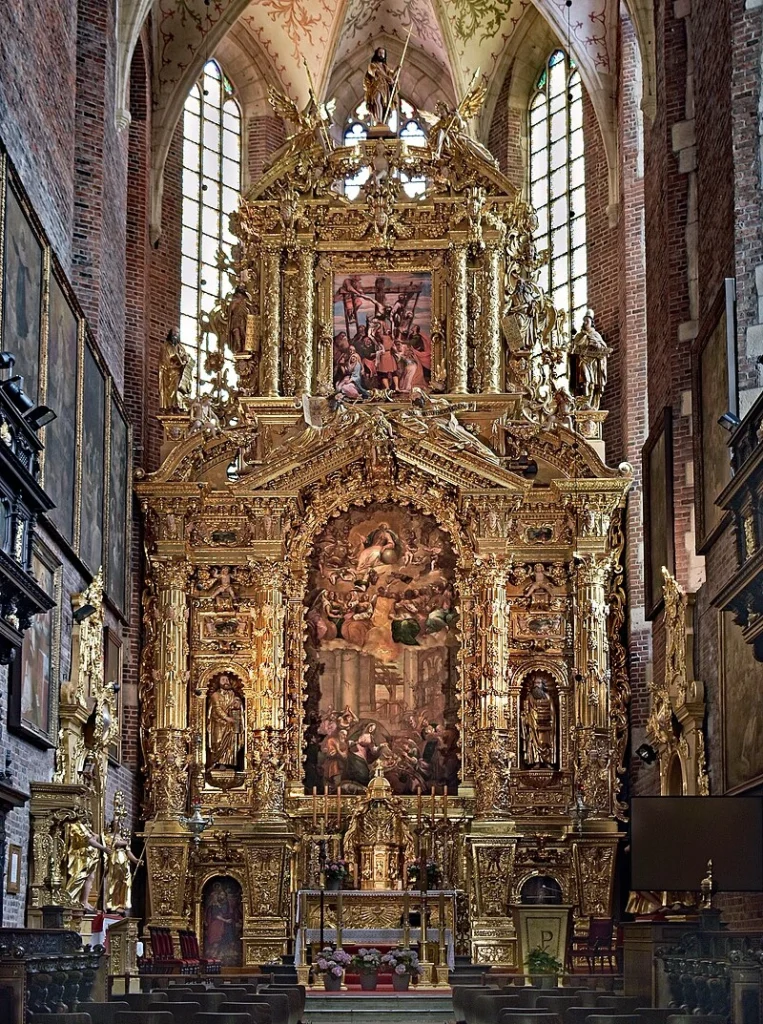
The main altar
The two-story main altar dates from the first half of the 17th century. It is 21 meters high. The inscription on it states that it was made in 1634 (Anno Domini 1634 hoc altare extructum ) during the provostship of Marcin Kłoczyński, in the style of the late Renaissance, and assembled between 1636 and 1637. The altar combines Italian architectural elements with Netherlandish decorative art. In the central part of the altarpiece is a painting by Thomas Dolabella, “The Adoration of the Shepherds.” Atop the altarpiece stands a figure of John the Baptist. A polygonal temple-shaped 17th-century Baroque tabernacle, a 1941 wooden antependium carved by Professor Wojciech Maciejowski depicting angelic adoration of the Host, and old paintings of St. Christopher and St. Joseph on the doors leading behind the altar. On each level are carved wooden figures of Old Testament prophets: Jeremiah, Moses, David, and Isaiah, and from the right: Ezekiel, Daniel, Zechariah, and Micah. The entire structure of the altarpiece is saturated with winged cherub heads, cartilaginous-auricular ornaments, and fruit and festoon patterns.

The main nave
A late Baroque pulpit in the shape of a boat with oars and a net is located on the left side of the nave, near a pillar. It was built in the middle of the 18th century. The sail serves as a canopy, with symbols of the Evangelists carved on the sides of the boat, and it is supported by mermaids and dolphins. Near the rainbow, on the left, is an altar with a painting of Christ the Savior, and on the right, an altar with a painting of the Madonna. In the year 1619, the Krakow artist Ukasz Porbski painted both of them.
Presbytery
The chancel is the width of the main nave. Along the walls are Mannerist stalls made between 1624 and 1632, with figures of saints and paintings on the backs depicting the history of the order (workshop of Tomasz Dolabella). The main altar, with paintings by Tomasz Dolabella, is wooden and richly gilded. It is most likely the work of the workshop of Baltazar Kunc . It was completed in 1637. The main altar painting is The Nativity of Christ by Tomasz Dolabella, and the finial is The Descent from the Cross (workshop of Dolabella). Above the entrance to the sacristy hang five paintings by Wojciech Podkora. To the right is a statue of St. Stanislaus of Kazimierczyk.
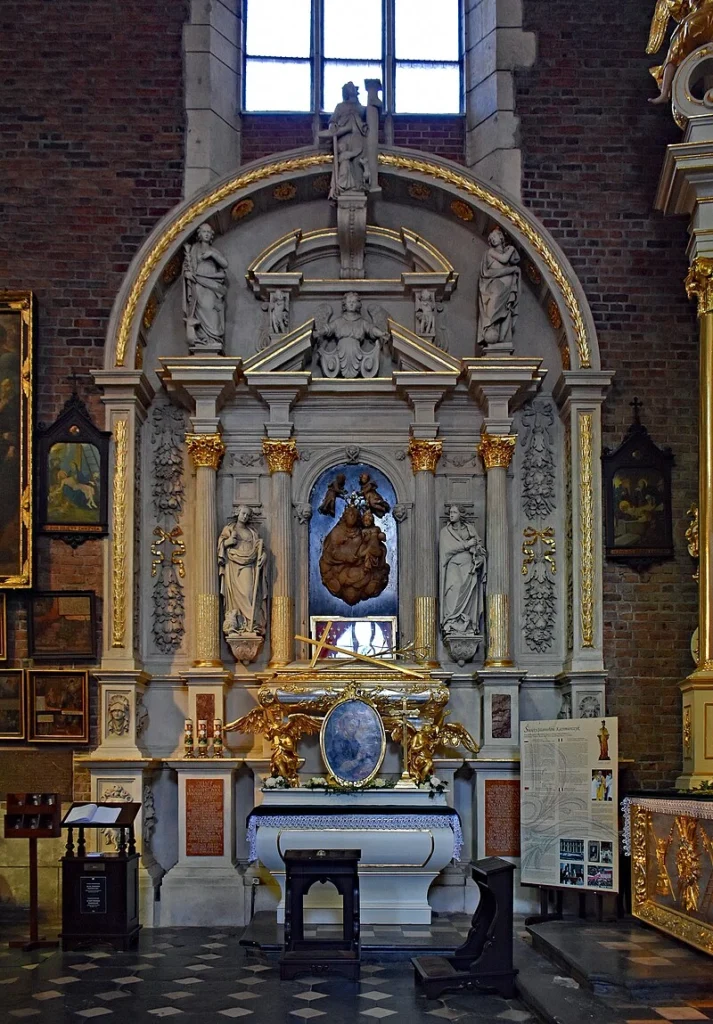
North nave (left)
It houses a Mannerist confession by Stanisław Kazimierczyk, as well as a neo-Renaissance plaque dedicated to Bartholomew Berrecci, who rests in the basilica. On the wall, among other things, are the painting “The Judgement of Pilate” by Łukasz Porębski from 1626, and the painting ” The Transfiguration of the Lord and St. Augustine” by Łukasz Orłowski.
South nave (right)
Adjacent to it is the Chapel of St. Anne, which is cared for by the Archconfraternity of the Blessed Sacrament and the Five Wounds of the Lord Jesus. Next to the altar with a painting of St. Anne by Łukasz Porębski is the tombstone of Bartholomew Berecci and the fraternity’s wardrobes covered with paintings. Next to it is the Chapel of the Annunciation , with a monumental portal, stucco decorations in the dome, and a bronze baptismal font from the first half of the 15th century. The altar contains a painting of the Madonna from the early 16th century, and beneath the chapel is a crypt.
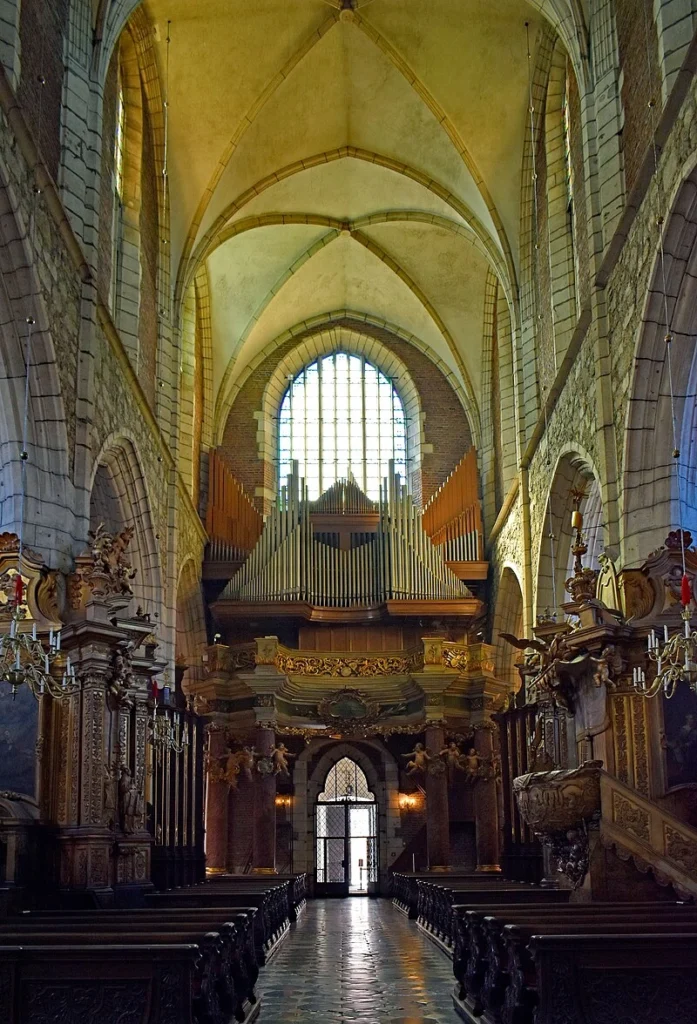
Organs
The organ in Corpus Christi Basilica is the biggest in Kraków when it comes to the number of stops. It has 83 stops, around 5,950 pipes, and 20 bells. There are two parts: the main organ with 63 voices is up in the choir loft, and the smaller one with 20 voices is in the presbytery. Both parts have their own keyboards and are connected by an electric system. The first organ in the church was built in 1373, but it burned down in a fire in 1594. Since then, the organ has been rebuilt and fixed many times. The last big repair was in 2016, when they worked on the main bellows to keep it working well.
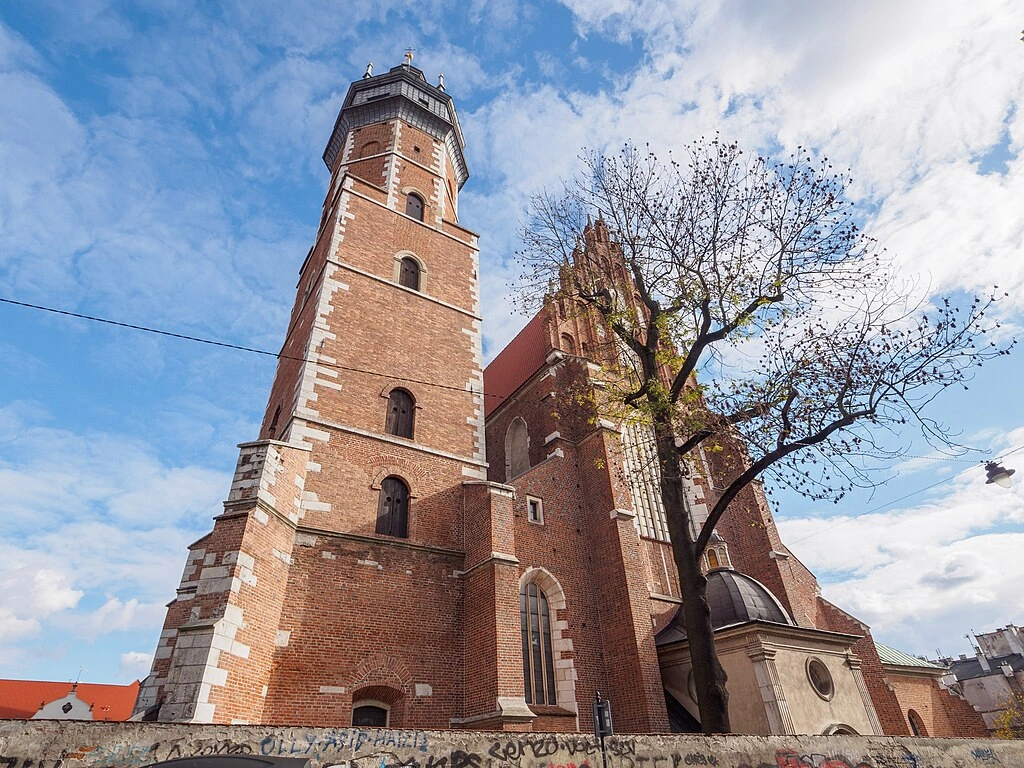
Bells
From the 70-meter tower of the Corpus Christi Basilica, the sound of five old bells rings out across Kraków’s Kazimierz district and beyond. These bells have been part of the city’s life for centuries. Right now, all of them hang in the main tower, but until 2006, one of them the Ave Bell was placed in a small turret on the church roof. The biggest bell is named Stanislaus and weighs about 2,500 kg. It was made in 1556 and has a deep tone. The next largest is Lawrence, around 800 kg, cast in 1938 using metal from an older bell called Peter. There’s also the Southerner, made in 1539, which weighs 270 kg. The smaller ones are Augustine (240 kg), cast in 1556, and the smallest one, known as the Signature bell, which weighs about 70 kg. Each bell has its own sound and history, and together they create a strong and beautiful chime that’s part of daily life in the area.
Legend
There is a legend associated with the church Driven by a repulsive hunger for gold, a large group of people in Kraków, incited by the devil, stealthily and secretly entered the parish church of All Saints during the octave of Corpus Christi and stole and carried away a copper, heavily gilded monstrance containing the Blessed Sacrament, of exquisite workmanship, exceeding the value of the precious metal. Later learning that the monstrance was copper, to avoid severe punishment if caught, they threw it into the overgrown Mate swamp, located not far from St. Lawrence’s Church, which was then the parish church of the village of Bawół, belonging to the Kraków chapter, where the Polish king Casimir II later founded and founded the city of Kazimierz. Heavenly lights burned on it [the swamp] night and day. When many people learned of this and recognized it, as it truly was, as a miracle, it was reported to the Bishop of Kraków, Bodzeta, and his venerable chapter, and then to the Polish King Casimir II, a very pious prince. They, recognizing that the appearance of so many and so great heavenly lights could not be without cause, ordered a procession of the entire city with hymns, songs, and banners, went to the muddy spot and carefully examined the mysterious lights. There, they determined that it was an illuminated stolen monstrance, they took it to All Saints’ Church. The most serene Polish king, Casimir, having recognized that such a memorable and extraordinary miracle had occurred for him and because of him, made a promise that in the place where this ineffable Sacrament was found, even though it was marshy and muddy, he would found and build a beautiful brick church in honor of Corpus Christi.
Feast Day
Feast Day : Thursday after Trinity Sunday, June 19 in 2025
The Basilica of Corpus Christi in Kraków, Poland, celebrates two important feast days each year. The main one is the Feast of Corpus Christi, held on the Thursday after Trinity Sunday, which is a movable date based on Easter falling on June 19 in 2025. This solemn celebration honors the real presence of Christ in the Eucharist and includes a traditional procession through the streets of Kraków. The second key feast is the Feast of St. Stanislaus of Kazimierczyk, one of the basilica’s patron saints, celebrated annually on May 5. Both feasts are central to the basilica’s religious life and draw many worshippers and visitors each year.
Church Mass Timing
Monday to Saturday : 8:00 AM, 12:00 PM, 6:00 PM
Sunday : 8:00 AM , 10:00 AM , 12:00 PM , 4:00 PM , 6:00 PM
Church Opening Time:
Monday to Saturday : 6:00 AM, 6:30 PM
Sunday : 6:00 AM, 8:00 PM
Contact Info
Address : Corpus Christi Basilica
Corpus Christi 26, 31-059 Kraków, Poland.
Phone : +48 12 430 59 95
Accommodations
Connectivities
Airway
Basilica of Corpus Christi, Krakow, Poland, to John Paul II International Airport, distance between 31m (25.5 km) via A4.
Railway
Basilica of Corpus Christi, Krakow, Poland, to Kraków’s Main Railway Station, distance between 14m (5.0 km) via II obwodnica.

